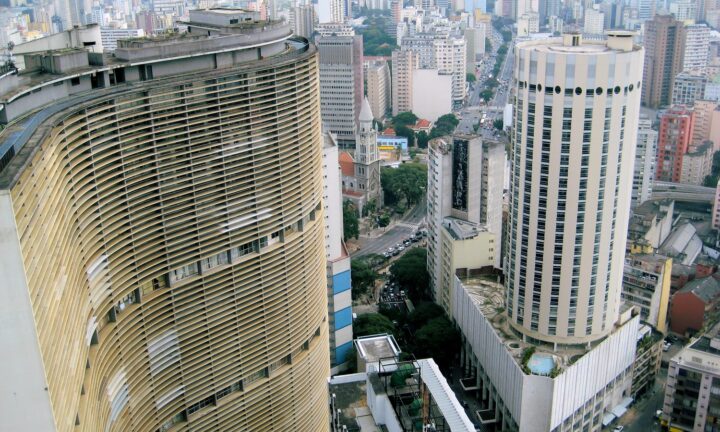
Edifício Copan – the largest residential building in the world
In the center of the Brazilian metropolis of São Paulo there is a building that cannot be overlooked. / Edifício Copan
The 165 meter high Edifício Copan, with its approximately 5000 residents, is the largest residential building in the world, some even call it a city within a city.
It was designed by the Brazilian star architect Oscar Niemeyer – originally for a completely different purpose.
32 floors, six blocks and more than 1000 apartments, in which an estimated 5000 people currently live: Welcome to the Edifício Copan, which according to the Guinness Book of Records has the largest floor area of any residential building in the world with its 116,153 square meters. The wave-shaped complex made of fair-faced concrete was designed by none other than Oscar Niemeyer, one of Brazil’s most influential architects.
The Edifício Copan was originally intended to be a tourist attraction to commemorate the 400th anniversary of São Paulo’s founding in 1954. It was planned to be a huge complex with restaurants, art galleries, a theatre, a cinema and apartments. A hotel was also to be housed in the Copan. “But because of political and economic problems, the copan is only
Inaugurated in 1966, two years after the military took power in Brazil,” said architect Carlos Lemos, who helped design the complex, in a radio feature on Deutschlandfunk Kultur.
Apartments in the Edifício Copan became a bestseller
Lemos finally took over the project completely from Oscar Niemeyer because he had been commissioned to build the new capital Brasília and was not allowed to pursue any other projects due to an exclusive contract. When the Edifício Copan opened in 1966, it had 1160 apartments of various sizes. The smallest apartments were 26 square meters, the largest 350 square meters. Numerous apartments were sold in no time. The central location in particular attracted many investors to invest here.
But the fact that Oscar Niemeyer designed the building also played a big role in the building’s popularity. “Oscar Niemeyer was one of the pioneers of modern architecture in Brazil,” says Brazilian architect Rafael Péra to TRAVELBOOK. “Unlike some other architects of his time, Niemeyer understood the spirit of the Brazilian climate and people – and did not simply use imported solutions.”
A dark chapter in the history of Edifício Copan
But after the initial hype, a dark chapter in the history of the largest residential building in the world soon followed: Because a new financial center was being built in another district of São Paulo, many companies from the city center moved there. The center and with it the Copan deteriorated rapidly, many residents moved out, prostitutes, drug dealers and other criminals moved in. “The downfall was really bad. The building has decayed from the inside,” says a woman who still lives in the Copan, in the “Deutschlandfunk” feature. “His reputation was so bad that when I asked where I lived, I just said: at the intersection of Ipiranga and São Luiz. We owe the rescue only to Don Affonso.”
Don Affonso, this is the current manager of the Edifício Copan. The now over 80-year-old has lived there himself since it opened. With an iron hand and with the help of a sophisticated network, he ensured that order was restored, kicked out the criminals and had cameras installed throughout the buildings. Today the Edifício Copan has more than 100 employees and operates like a small town. On the ground floor there is a row of shops with 70 shops, cafes and restaurants. In fact, the largest residential building even has its own postal code: CEP 01046-924.
Important building in Sao Paulo
“The Edifício Copan is a very well-known building and an important and popular place in São Paulo,” says architect Rafael Péra to TRAVELBOOK. “The strategic location and variety of sizes of the individual residential units creates a diverse, lively and diverse neighborhood, made up of different classes and occupants – both in the apartment area and in the commercial area on the ground floor – and blends very well with the city.”
Incidentally, the curved S-shape of the Edifício Copan is not due to the creativity of the architects. “It owes its existence to a coincidence,” explains Carlos Lemos in “Deutschlandfunk Kultur”. “When the Copan was being planned, the developer bought four plots of land in central São Paulo. Two from the Catholic Church, the third from a very rich man, and the fourth from an auto repair shop. The location of the plots dictated the shape of an S.”
Popular with tourists
Today the Edifício Copan is a landmark of São Paulo and a magnet for tourists and architecture fans. “The height and size of the Copan are impressive,” says architect Rafael Péra. “And very interesting is the open ground floor area. The ground there has a slight incline that follows the surrounding topography to better blend with the surrounding streets.”
You should not miss a trip to the roof terrace, because from there you have the best view of the city. This terrace opens, according to Tripadvisor users in their reviews, twice a day, at 10:30 a.m. and at 3:30 p.m. Registration takes place at the reception in block F of the Edifício Copan, entry is free.
There is an even bigger house
The Edifício Copan is in the Guinness Book of Records as the largest residential building in the world. However, there is a building complex in the Italian capital Rome that is much larger. According to a report in the Italian daily newspaper “La Repubblica”, 7,000 people live in 1,260 apartments on 9 floors in the so-called Corviale on the outskirts of Rome. It is considered one of the longest high-rise buildings in Europe – and a social hot spot in Rome.
Categories: General
